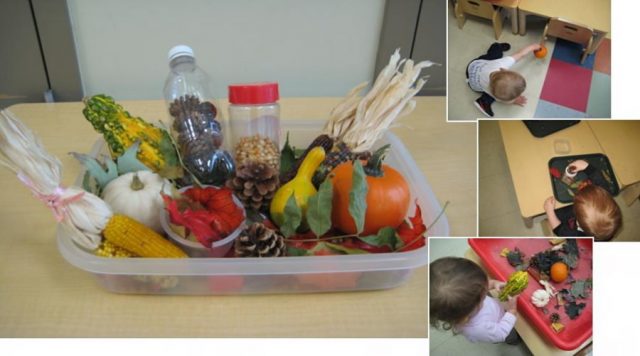
Importance of Sensorial Experiences
The five senses of touch, taste, smell, sight, and sounds are children’s information gathering tools. Sensory play allows the children to use their senses to gather information about the world around them. Simply put, children must explore to know. The only way they can truly understand and learn about their world is by seeing, touching, smelling, hearing, and sometimes even tasting it. Sensorial experiences strengthen the relationship between the mind and body. They also form concrete cognitive impressions that the child can later build upon when using their abstract/ theoretical minds.
Learning Objectives
Through this activity children are able to explore and experience the different types of objects and items that are often seen during the autumn season. This activity not only assists in fostering children’s sensory development, but also their fine motor, language and cognitive skills.
Materials
- Sensory bin
- Pumpkins (variety of sizes and colours)
- Leaves (variety of sizes, colours, and shapes)
- Pine cones (variety of sizes)
- Dried whole corns and kernels
- Gourds (variety of sizes, textures, and colours)
- Plastic cups or containers
Observations & Findings
Children explore the physical aspects of the objects by lifting, rolling, and throwing. Children learn to understand that each object may weigh differently, and some objects may roll while others may just fall on the ground when thrown.
Cognitive development is fostered through the child’s spatial exploration skills. Placing/ scooping objects such as leaves, kernels, and pine cones into different size containers, allows a child to recognize that not all the objects are the same size and certain objects may more easily fit into containers than others.
While holding these different objects, children can observe the different colours and textures. They can feel the smoothness or roughness of objects. They can also see how the same object may come in a variety of sizes and colours. Sensory exploration also fosters the child’s language development though the use of descriptive words and object recognition.
By putting the different objects into small containers/ bottles with lids, children are able to shake them and listen to the sound made. They learn to identify that certain objects may make louder sounds than others (example: kernels vs. pine cones); or one type of object can make different sounds, such as leaves (example: dried vs. fresh).
Continuing the Experience
Leaf Collage: Children stick different leaves on paper, making a colourful collage.
Pumpkin Exploration: By cutting the pumpkin open, children can see, touch, taste and smell what is inside.

